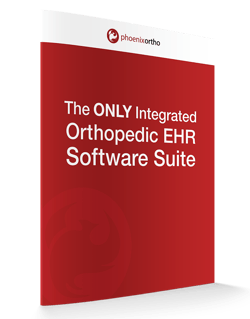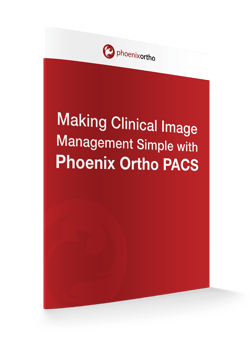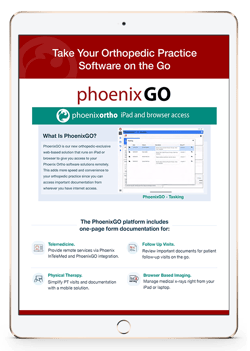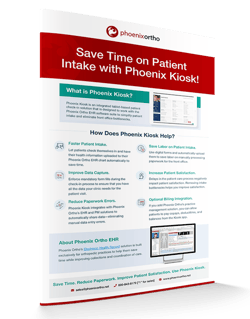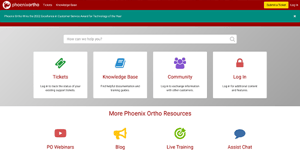Many doctors, regardless of specialization, entered the healthcare field to help people. However, an important part of any medical practice is managing the business aspect of things. Whether you’re an orthopedic doctor running a small private practice or an administrator for a network of clinics, mastering financial issues such as revenue cycle management (RCM) is crucial.
What is revenue cycle management? How can it affect your orthopedic clinic? And, what can you do to improve RCM in your healthcare practice?
What is Revenue Cycle Management in Healthcare?
A simple revenue cycle management definition would be: A series of financial processes that healthcare providers use to track patient care interactions to ensure that they are paid for the services they render.
RCM healthcare processes frequently involve the use of specialized software to track patient data (such as patient charts, specific services rendered, and visit notes). This is often important because many payer organizations (such as health insurance companies and government agencies) require detailed information about patient visits before approving a charge ticket submission.
What Factors Complicate RCM for Healthcare Facilities?
One major concern for RCM in healthcare is the issue of the increasing amount that patients have to pay out-of-pocket. As noted in an article by Healthcare Finance, “About 59% of patients in 2018 had an average out-of-pocket expense between $501 and $1,000 during a healthcare visit. This was a dramatic increase from 39% in 2017.” This increase in patient expenses has given rise to “consumerism” in healthcare—meaning that many patients are seeking lower-cost care when possible.
Additionally, the Healthcare Finance article notes that “34% of patients are finding it difficult to pay their deductible before insurance kicks in… providers are also feeling the pressure of increased denial rates and write-offs, which is increasing bad debt.” This increase in claim rejections complicates the RCM process and creates delays in collections. These delays can be problematic because orthopedic clinics typically have to shoulder the burden of the cost of care until the patient and/or payer organization make their payments.
Effective healthcare revenue cycle management is a must for orthopedic clinics to ensure a consistent and steady cash flow. Without the right RCM tools and processes in place, collecting on services rendered can be a struggle for orthopedic clinics, resulting in delinquent payments and financial hardship.
How to Improve Your Revenue Cycle Management
So, how can your practice improve its RCM practices to increase collections and avoid bad debt? Here are a few tips that may prove useful:
1: Focus on Collecting Payment at the Point of Care
Having patients pay for orthopedic care at the time services are rendered helps to improve cash flow and avoid delinquent payments. Being able to collect on a patient’s portion of the cost of care can be incredibly helpful for maximizing the clinic’s cash flow.
However, to collect at the point of care, orthopedic clinics will need reliable tools for assigning patient visit codes quickly, submitting charge tickets to the automated clearinghouse (ACH), and processing patient payments.
2: Provide Patients with Several Options for Paying for Services
Patients may have many different forms of payment that they prefer to use. Some options include cash, checks, and credit/debit cards.
Being able to process different forms of payment makes it easier to collect at the time of care. It also makes it easier for patients to pay for care in general; instead of having to prepare a specific payment method or shuffle funds between accounts, they can use the most convenient payment method they have at hand.
3: Use an Automated Clearinghouse to Process Claims
The days of manually submitting claims via so-called “snail mail” are done. Manual charge ticket submissions using paper forms take far too long for modern processes—especially when such claims are rejected and need to be amended before resubmission.
Using a practice management (PM) solution that incorporates an automated clearinghouse system helps to greatly improve collections. Instead of waiting for days to have a claim sent, processed, and approved/rejected, orthopedic physicians can submit claims electronically and have a response in minutes. This can greatly improve collections for an orthopedic clinic.
4: Apply Electronic Health Records (EHR) Technology to Capture Visit Data
To be able to submit a claim for services rendered, orthopedists need to have a precise accounting of the patient visit. Without thorough data, the evaluation and management (E&M) codes for the visit cannot be reliably established, which may lead to under- or over-billing for the patient visit and trigger billing code audits or payment disputes from third parties.
Having more information available about the patient visit frequently allows for it to be billed using a more valuable code. This is where an EHR solution can help.
Electronic Health Records solutions like Phoenix Ortho EHR allow doctors, nurses, and/or assistants to capture critical visit details and create a thorough report that combines visit notes, image orders, and other data to help establish the correct billing code for the visit. This helps to make billing easier while preventing audits and other issues that may delay collection.
5: Consider Providing Payment Plan Options for Patients Facing Financial Hardship
As the cost of care continues to rise, it’s becoming more difficult for some patients to pay their orthopedic medical bills all at once. Here, creating a payment plan for orthopedic patients can help.
Instead of billing the full value of the visit all at once, patients on a payment plan only pay a portion of the costs each month. The size of the payments and the duration of the plan would need to vary based on the amount of debt owed and the patient’s financial situation.
For example, if a patient owes $1,000 for orthopedic care after their insurance is taken into account, that patient could pay $100/month for ten months, or $250/month for four months (not including any interest that may be assessed). This helps spread out the cost of care so the bill is more manageable for patients.
Allowing for payment plans may be especially important following the economic disruption caused by COVID-19. According to data from the Pew Research Center, “The number of employed workers fell by 24.7 million from February to April 2020 as the outbreak shuttered many parts of the economy.” Many patients may be facing economic hardship and have difficulty paying large healthcare expenses all at once.
Need help optimizing your revenue cycle management? Learn more about how the Phoenix Ortho software suite can help your clinic optimize its RCM by reaching out today!
Schedule a 1:1
Get in touch with Phoenix Ortho to learn more about how you can save time, money, and mouse clicks with an orthopedic-specific EHR.





